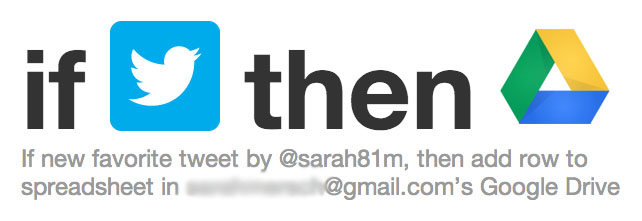Tools & Apps for Journalists: If This Then That

If This Then That (commonly known as IFTTT, pronounced ‘ift’, like the word ‘gift’) is a neat little online tool that can magically simplify your online activities by automating tasks. It’s based on the idea of “if this happens, then do that”. When I publish this post on WordPress (the ‘if this’ part), I can use IFTTT to automatically post the link to my Facebook account (the ‘then that’ part). Or else, every time I like a track on SoundCloud, I can get IFTTT to download it automatically to my Dropbox.
IFTTT supports a whole bunch of online applications (including all the major ones). The tool works by simple rules so that each specific event triggers a specific action. IFTTT calls these rules ‘recipes’. Once you have granted IFTTT access to the apps you use, you can create your own individual recipes.
IFTTT walks you through the process step by step and it’s really easy to use.
How can journalists use IFTTT?
There are endless recipes on the IFTTT website, and several sites on the net listing the best recipes for journalists (here’s one for example). Some of the recipes are really practical especially when it comes to keeping track of information and organizing your work.
Stay on top of information
I use Twitter a lot for work and ‘Favorite’ everything that I might want to read later. But scrolling down your Twitter favorites list is a very impractical way to retrieve tweets. What works great for me, though, is to have all my favorites end up in a special doc on my Google Drive, where they are easily searchable by author and date.
My IFTTT recipe then looks like this. “If I favorite a Tweet, then save it to my Google Drive”.
 I can set this up easily by clicking on the icons on the IFTTT website. It works quite well for me, as I usually remember who tweeted the thing I am looking for. But unfortunately while it keeps the URL of the tweet, it doesn’t show the text, so usually I have to open several tweets before finding the one I am looking for.
I can set this up easily by clicking on the icons on the IFTTT website. It works quite well for me, as I usually remember who tweeted the thing I am looking for. But unfortunately while it keeps the URL of the tweet, it doesn’t show the text, so usually I have to open several tweets before finding the one I am looking for.
Other way to use IFTTT is when you are working on a specific topic, you can set IFTTT to search your RSS feed for a keyword and send you an email alert.
The New York Times even has its own channel on IFTTT, so you can create alerts for new articles on specific topics or events. Or if your favorite photographer adds a new picture on Flickr, you can instantly get an alert sent to your preferred app. The possibilities are endless.
Organizing your work
Once you have all your research material in place, IFTTT also allows you to organize your work more efficiently. You can automatically add events to your calendar or get IFTTT to automatically download Gmail attachments to Dropbox or choose a host of other ways to make sure that none of your important information gets lost.
I use Facebook a lot for work but also for personal matters. So sometimes it gets difficult keeping track of everything and dividing up the important and less important information. What helps me a lot is this recipe that adds Facebook events posted in a defined group automatically to my calendar. This makes sure that I don’t miss out on potentially work-related events that are published in discussion groups I use on certain topics, but don’t necessarily consult every day. But because it only adds events from certain groups, it means I don’t get party invitations cluttering up my calendar at the same time.
Offline? Doesn’t matter
The IFTTT SMS service can come in handy when you don’t have constant internet access or if you don’t have a smartphone. Waiting for a really important email from your boss? Your phone can tell you when it’s time to start searching for an internet cafe. Simply set up a recipe: “If mail from bigboss@mycompany.com, then send me an SMS” (here’s how to activate the SMS channel).
Or you might have set up Google Alerts to send you an email when there are reports of violence during elections you’re covering but you don’t always have internet access. You can set up the recipe: “If mail from Google Alerts, then send me an SMS”.
Promoting your work
Last but not least, IFTTT can also save you time when it comes to getting your work out on the web. This recipe, for example, automatically tweets new posts on your WordPress blog. You could use a similar one to boost new articles on LinkedIn, or automatically publish your pictures from Flickr or Instagram on your Tumblr, which is practical if you’re covering a big event.
What else should journalists know about IFTTT?
Cost: free
Languages: English
Apps: An iPhone app came out in late 2013, including location based services; an Android app is expected in early 2014.
Disadvantages: Even though IFTTT supports 78 social media networks and other services (which IFTTT calls ‘channels’), your favorite app might not be supported. The SMS channel doesn’t work in every corner of the globe.
Written by Sarah Mersch, edited by Kate Hairsine



